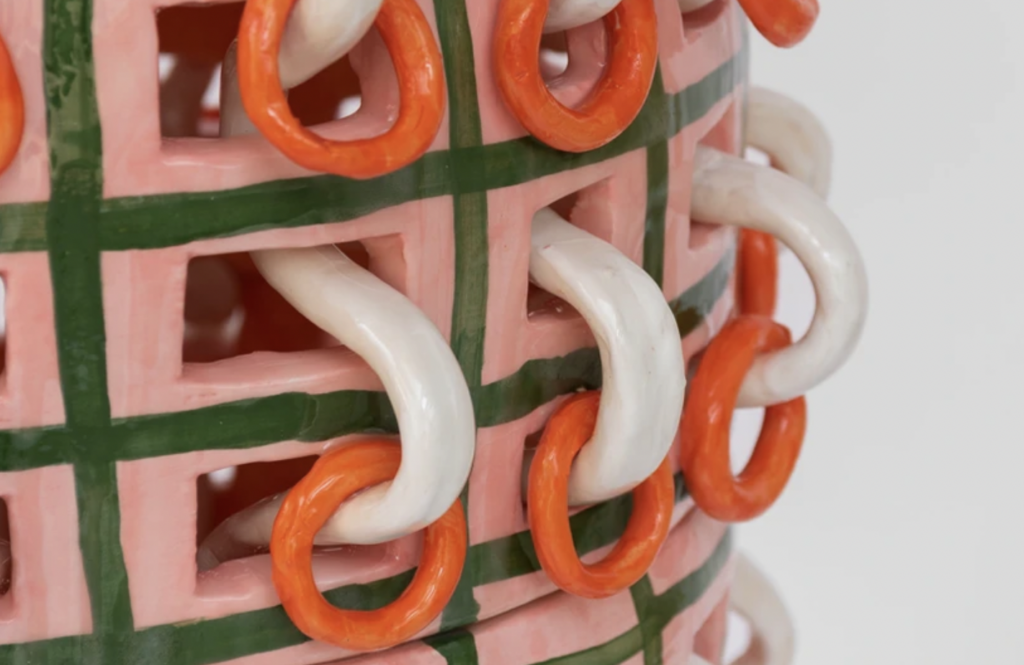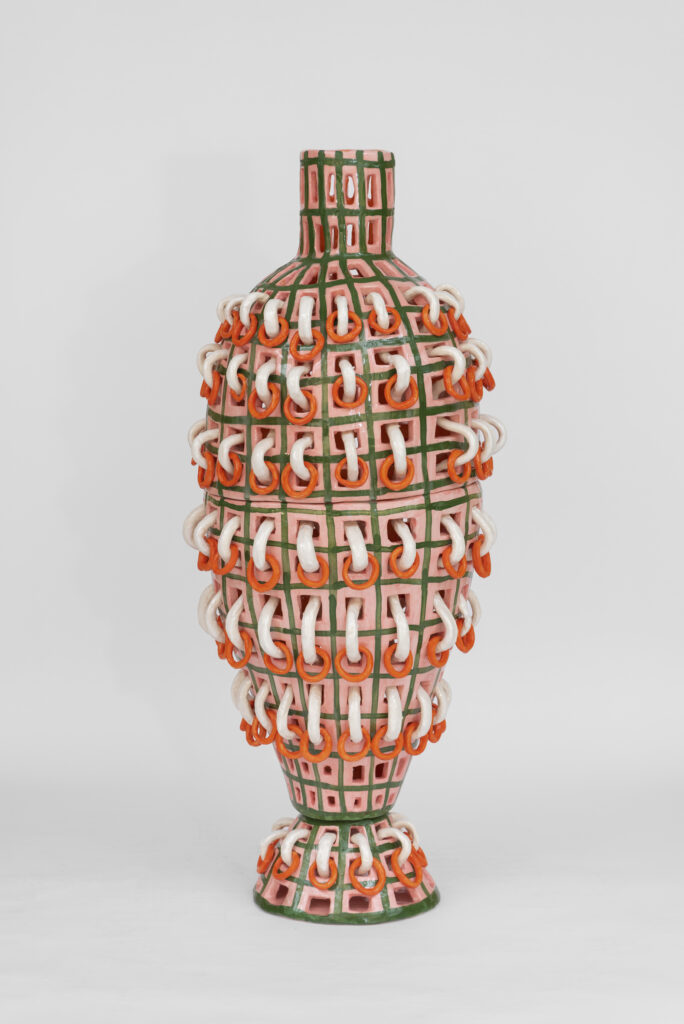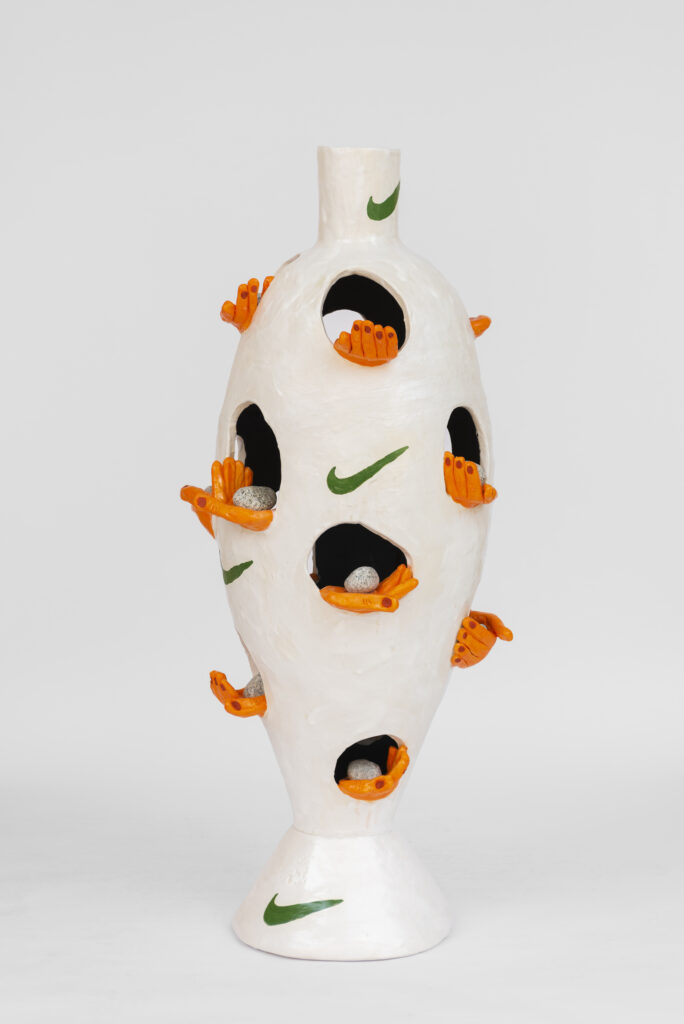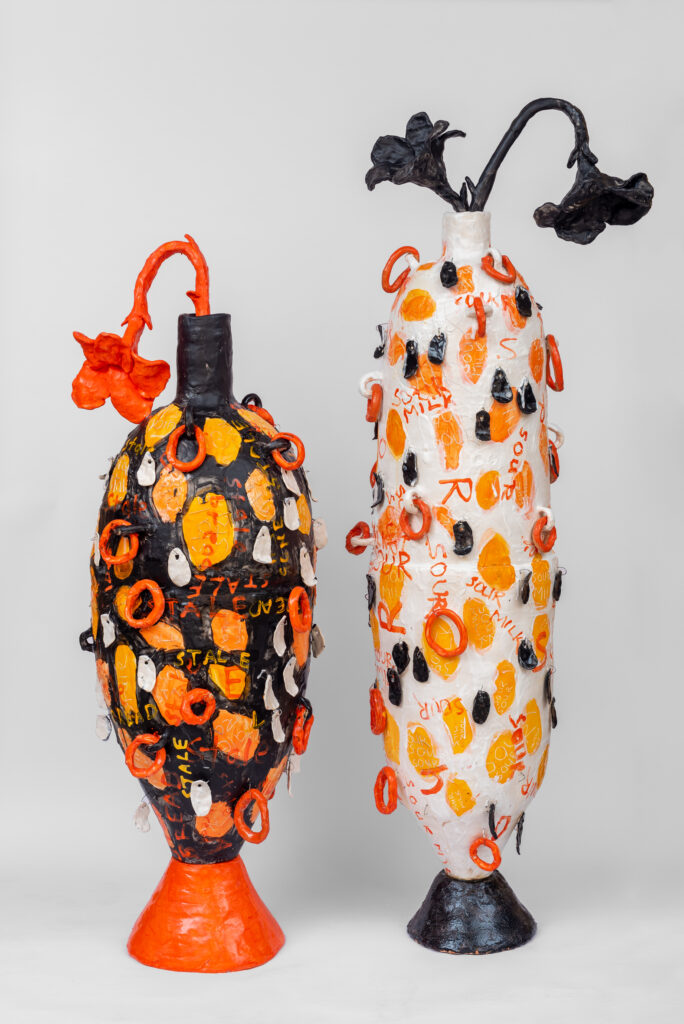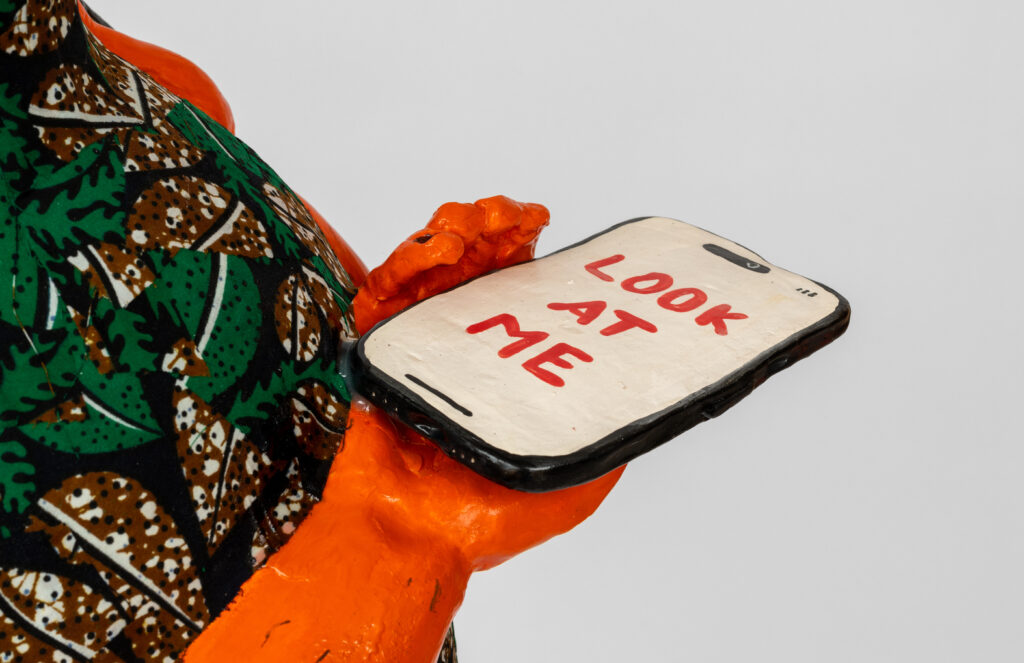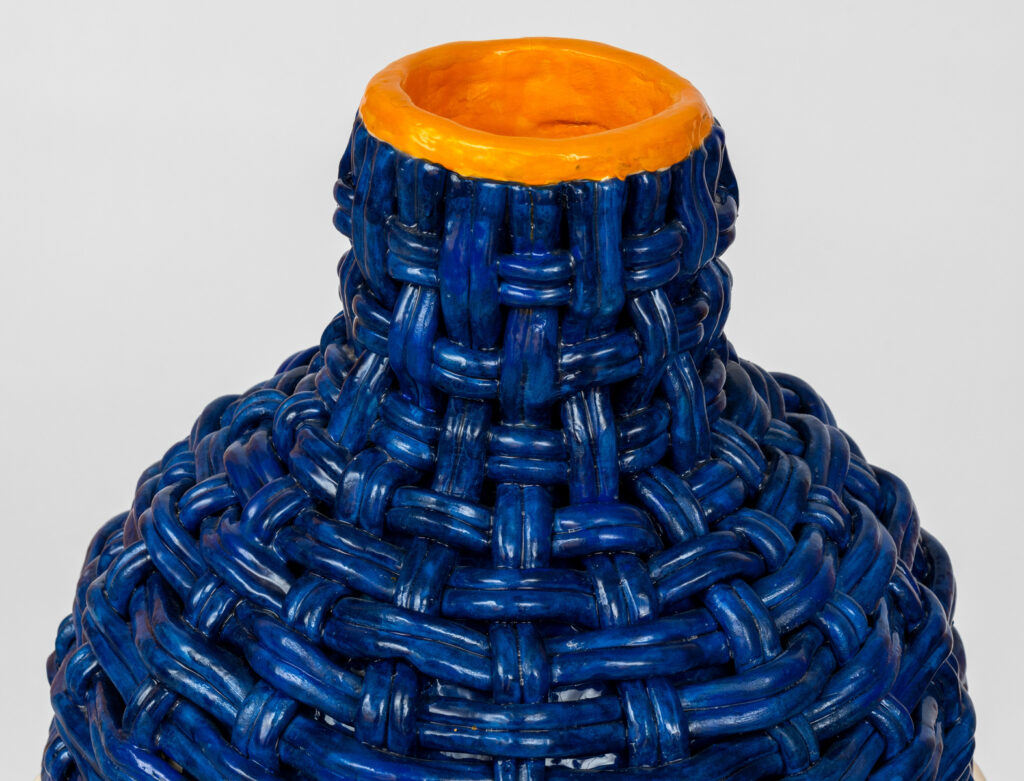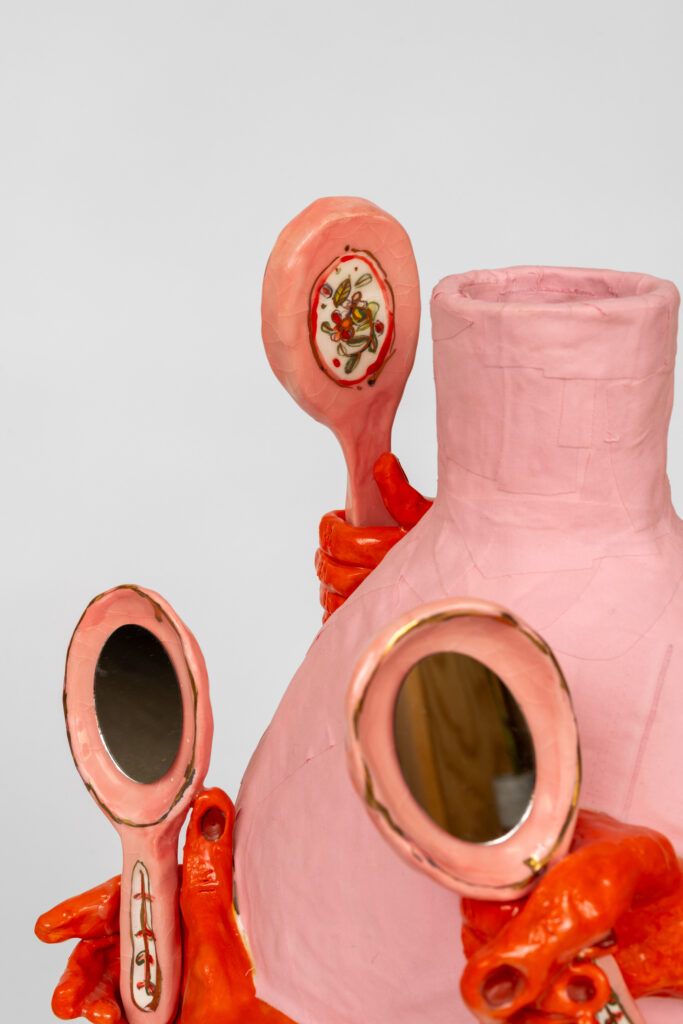
Ceramic artist Xanthe Somers was born in Harare, Zimbabwe in 1992. She currently lives and works in London, UK.
Recent exhibitions include AKAA Art Fair in Paris with ARTHarare
(2023) and Collect Art Fair at Somerset House in London with Galerie Revel (2023).
interview with ceramic artist xanthe somers
Xanthe Somers was born in Harare, Zimbabwe in 1992. Having studied Fine Art at Michaelis School, University of Cape Town, she later completed her Master’s Degree from Goldsmiths, University of London in Postcolonial Culture and Global Policy. Inspired by both her studies and upbringing, Somers seeks to create works that question the colonial legacies of her country – the impact of materiality and profit-seeking entities that have had such a strong influence on the lens through which we encounter such materiality. Somers pulls threads together in clay; the lingering memory of bygone colonial artefacts that populated the homes of her childhood growing up in Zimbabwe, the remembrance of these bulbous shapes swollen with the past – lamps, urns, vessels and candlesticks. Somers draws together and twists these historical silhouettes, distorting their previous refinement, poking holes in them, dripping them with brash colour and allowing flowers like weeds to grow unchecked from their crevices. Additionally, the quiet whispers of many woven traditions, something deeply entrenched within Zimbabwean history, can be glimpsed in the threads, cords and loops of ceramic elasticity common in Somers’ work. Driven by a spirit of innovation, Somers approaches ceramics with a self-taught zeal, exploring its rich possibilities. Her artistry melds the ancient origins of the medium with contemporary bursts of colour and scale. This distinctive approach positions her as a prominent figure in today’s ceramic art scene, skillfully intertwining modern aesthetics with time-honoured techniques. Through this harmonious synthesis, she prompts a nuanced re-evaluation of traditional concepts within the contemporary context.
How long have you been working with clay?
I started working with clay in 2019 as a way to exercise my creative self whilst doing an MA in Postcolonial Culture at Goldsmiths in London.
How would you define clay and your relationship to it?
I find there is only so much I can make the clay do, and the clay decides the rest. I am not a naturally patient person, however hand-building large, detailed works requires endless time spent with the clay, and with yourself. Each day, for me, feels like a lesson in patience. Clay is such an incredible vessel for holding narratives. I think mostly I am invigorated by its ability to hold: to hold water, to hold function, to give shape, to carry stories and to carry meaning. Clay can be worth a few pennies in the shape of a mass-made mug or worth millions as fine china. It has a unique ability to cross the boundaries between functionality, art, class, and culture and because of this it is a vital medium to hold stories about humankind. The objects we make are not inert and have the ability to outlive their makers, giving us windows into the times they were made in. I understand clay to be an archive for the stories of humans. There is something very poetic about clay taken from the ground we exist upon, being the housing for our histories.
Which artists, either contemporary and/or historical, have had an impact on you over time?
I studied BA Fine Arts here in Cape Town which developed my deep appreciation for contemporary African art history and the artists who have helped shape it. To name a few who I am currently inspired by: Moffat Takadiwa, Kiluanji Kia Henda, Georgina Gratrix and Kudzanai Chiurai.
What other influences have seeped into your work during your career?
I grew up in Zimbabwe in a very privileged environment, in a country riddled with the remnants of colonialism. I studied Fine Art at UCT during the Rhodes Must Fall movement which influenced my decision to study Postcolonial Culture as a Master’s programme at Goldsmiths in London. I think I use clay as a way to understand my own role as a white Zimbabwean, and more broadly to examine the ideas of white supremacy, labour practices and eco-racism within Zimbabwe which are arguably propagated by the Christian-colonial-capitalist gaze. I am currently working on a body of monuments for women. They seek to celebrate womanhood but also to honour practices which are considered ‘women’s work’, such as weaving, textiles, childcare, mending, storytelling, community building, homemaking — all of which have been belittled and under-valued through capitals unspoken slogan of ‘profit-over-people’. If ‘women’s work’ is supposed to be a gentle, domestic, quiet, necessary craft, my aim is to honour these practices by making loud and bold sculptures in the shape of monumental domestic vessels.
Are there any traditional threads that exist in your practice? If so, what are they?
As I am a self-taught ceramicist I do not think I have a traditional approach to the medium. However, I do use many traditional motifs within my work such as the shape of the domestic, archetypal vessel, and the weaving techniques I replicate with clay. I use weaving as a way to look at social cohesion and community building.
Can you explain your process of making?
I usually start with a sketch, but more to get my ideas out of my head. I then slowly hand-build with coils in stoneware clay. It usually transforms during the making process into something quite different from the original sketch. Each piece usually goes through the kiln several times to add more layers, and accentuate different colours.
What role does experimentation play in your artistic practice?
Experimentation has always been at the heart of what I do. As a self-taught ceramicist, my way of learning has been entirely through trial and error. There is an area in my studio which I call ‘the graveyard’ where my unsuccessful sculptures live – it is always disappointing when they don’t work out but all the more pleasing when they do. I am very interested in the language of materiality within the works that I make, and usually integrate other materials into my pieces such as soapstone, granite, natural fibres and wax fabric.
What role does colour play in your work?
I think humans are like bees — attracted to colour. I use bold colours as a way to draw attention to my sculptures, then slowly once the viewer stays with the piece a bit longer they will hopefully begin to see the undercurrents within the themes of the work and their satirical tone.
What is your perception of the recent surge in interest in ceramic art?
It is fantastic to see a growing interest in clay, bringing it within the fine art canon. Textile art, weaving and ceramics, which have been until recently largely excluded from the art world, deserve to be recognised along with the artists who have made this possible.
“I understand clay to be an archive for the stories of humanity. There is something very poetic about clay taken from the ground we exist upon, being the housing for our histories.” [Xanthe Somers, Ceramic Artist]

